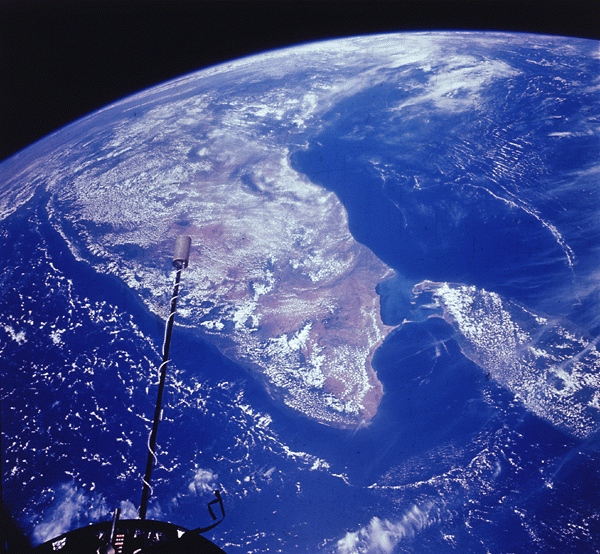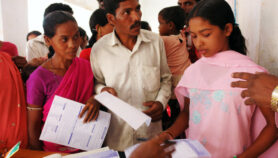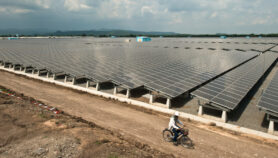Send to a friend
The details you provide on this page will not be used to send unsolicited email, and will not be sold to a 3rd party. See privacy policy.
New opportunities for South Asian collaboration in space technologies can help reduce poverty and promote sustainable development, says Nalaka Gunawardene.
Both China and India are keen to enhance links with smaller Asian countries in using satellites for communications, weather services, land use monitoring and navigation.
They have also realised the value of ‘space diplomacy’, or using space related technical cooperation for strengthening foreign relations.
The new government of India, elected in May, seems to have noticed China’s growing influence in this domain. On 30 June 2014, soon after India launched five new foreign satellites, Indian prime minister Narendra Modi challenged Indian space scientists to develop a regional satellite that would be shared with its neighbouring nations "as a gift from India.”
He envisaged that a dedicated South Asian satellite could provide “a full range of applications and services”. India already shares disaster management data with over 30 countries and provides telemedicine support to Afghanistan and African countries, he noted.
Modi urged the Indian Space Research Organisation (ISRO) to “enlarge the footprint of our satellite-based navigation system, to cover all of South Asia.” [1]
South Asia in Space
To date, only two South Asian countries have sent up satellites – but several others are trying to follow.
India’s first indigenously-built satellite, Aryabhata, was launched by the former Soviet Union in April 1975. ISRO acquired own launch capability in 1980. [2]
India has since developed end-to-end capabilities in space. It can now build and launch heavy duty rockets, and produce sophisticated satellites. It currently has the largest fleet of communication satellites (10) operated by an Asian country, as well as a dozen remote sensing satellites — with day and night viewing capability — covering the entire planet. In November 2013, ISRO launched a spacecraft to Mars, the first attempt at interplanetary exploration by an Asian country. [3]
India first offered to launch foreign satellites in 1999, and has so far sent up 40. Promoting itself as a reliable, low-cost launch facility, ISRO is keen to get a larger share of the global space market estimated to be worth around US$ 300 billion a year. [4]
Pakistan, which in the early 1960s started the first national space programme in South Asia, has lagged behind. It was in July 1990 that Pakistan’s Space and Upper Atmosphere Research Commission launched its first experimental satellite, Badr-1, using a Chinese rocket. [5] The agency continues to rely on foreign collaborators: its first fully functional communication satellite, Paksat-1R, was designed, built and launched by China in August 2011. Only a few components were made by Pakistani engineers. [6]
In late 2012, a state-owned Chinese company also played the lead role in launching a communications satellite in partnership with a Lankan company. [7] The project was hailed as a national accomplishment. But Sri Lanka’s senior minister for scientific affairs, Tissa Vitharana, told Parliament in April 2014 that there was no governmental involvement or investment in that purely private effort. [8]
Meanwhile, Bangladesh is working on its first satellite, called Bangabandhu, in partnership with a US company. Undertaken by the Bangladesh Telecommunications Regulatory Commission, this communications satellite will boost telecom and broadcasting services when it goes up in 2015. [9]
There have been some reports that Afghanistan, the Maldives and Nepal are also exploring national satellite projects with Chinese assistance. [10] [7]
SAARC Satellite
Whether low- and middle-income countries should invest their funds and technical skills in having own satellites has been debated for a long time. Some governments embark on such grandiose projects more for national vanity than for any tangible economic or scientific benefits. I call them ‘charismatic mega-science’. [11]
The smarter choice, for smaller countries, is to strengthen their technical and institutional capacity on the ground. That enables them to make the best use of regionally or globally sourced space data and other services.
A similar model worked well when countries plugged in to the Internet without each reinventing the global "information infrastructure.
"The smarter choice, for smaller countries, is to strengthen their technical and institutional capacity on the ground. That enables them to make the best use of regionally or globally sourced space data and other services."By Nalaka Gunawardene
The idea of a common satellite has been occasionally discussed by the inter-governmental forum of South Asian Association for Regional Co-operation (SAARC) whose members are Afghanistan, Bangladesh, Bhutan, India, the Maldives, Nepal, Pakistan and Sri Lanka.
Meeting in Dhaka, Bangladesh, in April 1998, SAARC information ministers agreed in principle on a SAARC satellite. However, it could not be pursued due to India-Pakistan political tensions that heightened shortly afterwards. With Prime Minister Modi reviving the idea, some feel its time has finally come. [12]
Many or all South Asian countries share common geophysical, meteorological and oceanographic factors – such as the Himalayas, Bay of Bengal, and rain-carrying monsoons. Space-based platforms can provide trans-boundary perspectives invaluable for more accurate weather forecasting, disaster risk reduction (DRR), crop harvest projections and other purposes.
Real-time sharing of regional satellite data is especially critical in DRR. This is recognised in ‘SAARC Road Maps on Risk Management in South Asia’ prepared in 2011 by the New Delhi-based SAARC Disaster Management Centre.
The document says: “The tropical region of South Asia with non-linear processes need denser network of observations. What is presently available in South Asia is hardly 20-30 per cent of these requirements. An extremely high-risk region is in fact poorly populated by the observational networks.” [13]
Indian satellites already have the South Asia neighbourhood and parts of Indian Ocean well covered. If governments can agree on modalities for sharing the massive stream of data coming from the skies, countries can focus on building or expanding systems that apply it for national needs.
For this to succeed, India must engender greater trust among its neighbours. One measure is to place technical and humanitarian co-operation above the interests of commerce and politics.
Vikram Sarabhai and Abdus Salam, space pioneers of India and Pakistan respectively, were scientific visionaries who wanted their nations to use the tools of space to benefit all citizens. They also wanted to engage the world with first class research in space applications.
Heirs to that legacy, their successors must carefully balance orbital dreams with ground realities.
Nalaka Gunawardene is a Colombo-based science writer, blogger and development communication consultant. He is also a trustee of SciDev.Net. The views in this column are his own.
This article has been produced by SciDev.Net's South Asia desk.
References
[1] Text speech of Prime Minister Narendra Modi at PSLV-C23 launch at Sriharikota, 30 June 2014.
[2] Indian Space Research Organisation (ISRO) website.
[3] Reaching for the skies – India’s space technology at its best, by Pallava Bagla. Saudi Gazette. 26 January 2014.
[4] India Launches Five Foreign Satellites. The Wall Street Journal. 30 June 2014.
[5] Pakistan’s Space and Upper Atmosphere Research Commission (SUPARCO) website.
[6] Lagging behind: 2040 – Pakistan’s space od[d]yssey. By Salman Siddiqui. The Express Tribune, Pakistan. 1 August 2012.
[7] China to Launch Satellite for Sri Lanka: India’s Missed Opportunity?
[8] Hansard report, Proceedings of Sri Lanka Parliament, 8 April 2014 (columns 983-986).
[9] Satellite Project. BRTC website, Bangldesh.
[10] Nepal may turn to China for satellite plan. The Hindu. 6 May 2013.
[11] Government interference ‘impeding science reporting’. SciDev.Net
20 April 2007.
[12] Thanks to Modi, SAARC Satellite’s Time has Finally Come. By Rajeev Sharma. First Post. 1 July 2014.
[13] SAARC Road Maps on Risk Management in South Asia. SAARC Disaster Management Centre, New Delhi. August 2011.














